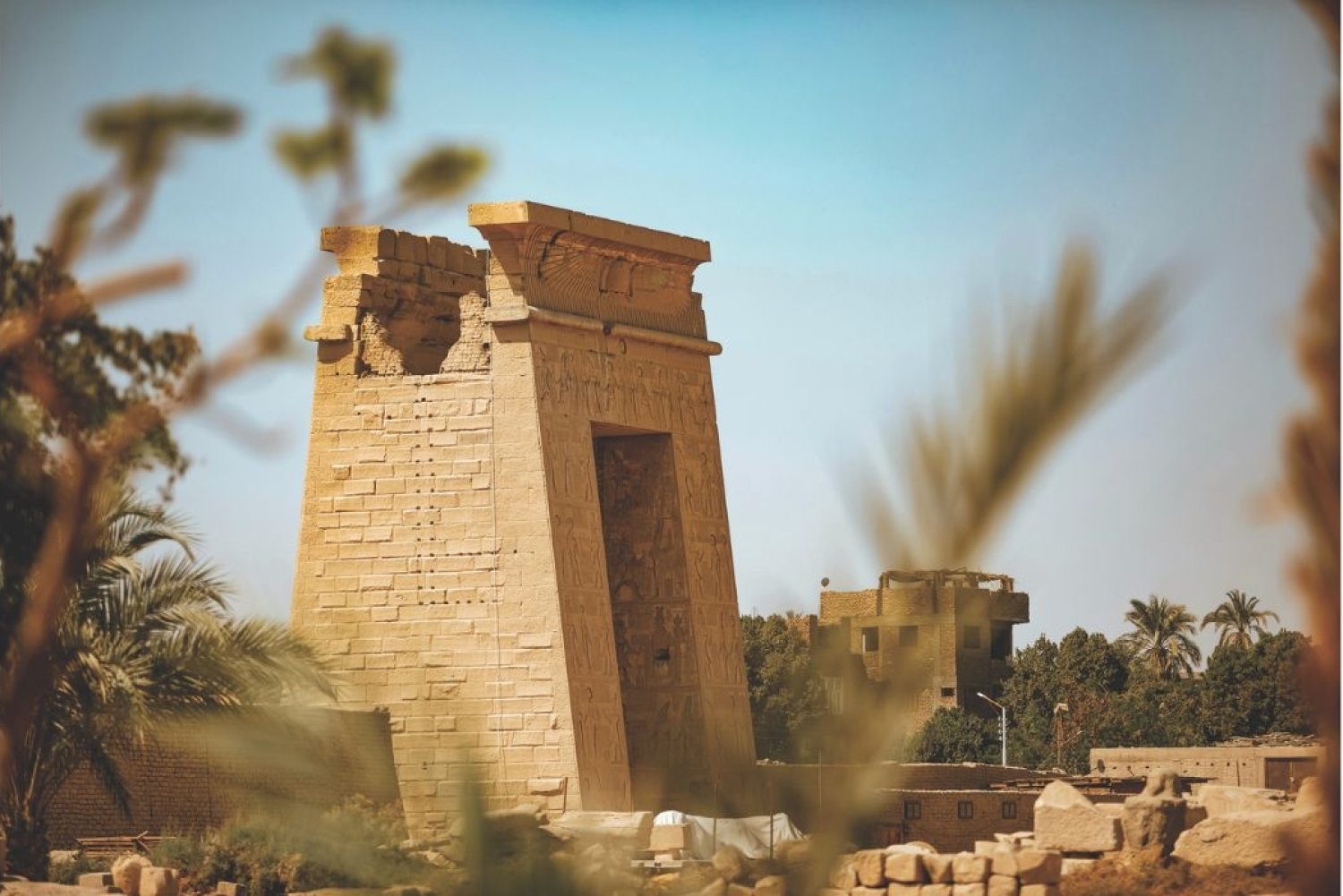

Travelling through Egypt during Ramadan was serendipitously accidental, my being an advocate of slow living. I landed in sweltering Cairo on a sunny afternoon, and I could feel a built-up anticipation in the air. In the narrow lanes, the usual hurriedness gave way to a thoughtful calm, reflecting a collective slowing down. The markets breathed a soft pulse in preparation for Iftar. Bottles of vibrant drinks were being stacked, food counters set up. Around 6 p.m., a young boy handed me a bag of refreshments—water, fruit juice and a few dates. I watched as he offered bags, generously, to each passerby. A simple gesture, which revealed the essence of Ramadan to me: a collective pause, a quiet generosity and a deep-rooted spirit of community.
LISTENING TO STONE: INSIDE THE GREAT PYRAMID
I arrived early at the Giza complex, where the Pyramids and the Sphinx rise in silent grandeur. That same day, reports surfaced of vast underground structures—possibly stretching two kilometres beneath the Pyramid of Khufu. Leaked images hinted at spiral wells, geometric corridors and hidden chambers beneath the pyramid—suggesting not crude remnants but sophisticated, intentional architecture.
That day I was among the first to enter the pyramid of Khufu —the largest and most mysterious of them all. The narrow, steep passageways force you to bend low, almost as if you’re being invited to enter with humility. I made my way upward, crouched and careful, into the heart of the structure. The main chamber was small and dim and already beginning to fill with people. In the quiet, I overheard a guide say something that stayed with me: This isn’t just a tomb—it’s a cosmic machine for resurrection.
He explained that it was built not only as a resting place but as a portal—something designed to guide the soul beyond. In that moment, the pyramid felt less like a monument and more like a bridge between worlds, a sign of how deeply the ancient Egyptians were connected to the mysteries of the afterlife.
When entering the complex and its minimal terrain one wonders, why this was such a revered place for them. Turns out the entire Giza plateau was laid out as a statement depicting Cosmic order – Ma’at (pronounced mah-aht) was the ancient Egyptian concept of cosmic balance, harmony and truth. The three large pyramids of Giza are aligned to mimic the three stars in Orion’s Belt—a kind of architectural mirror of the heavens.
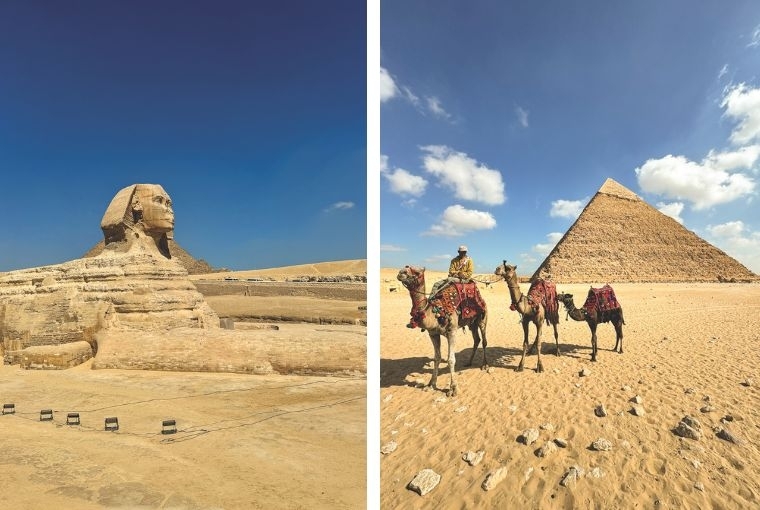
THE SACRED SILENCE OF SINAI
There are places that feel less like destinations and more like doorways. Sinai is one of them. This peninsular region is one of Egypt’s most captivating and spiritually resonant sites—where desert, sea and sacred stories meet. It’s also where continents touch each other lightly—Africa on one side, Asia on the other—belonging entirely to neither. Bordered by the Mediterranean and Red Sea to the North and South, Sinai feels like a threshold—a place between worlds, both geographically and spiritually.
Deciding to drive through this terrain wasn’t an obvious choice but probably the most rewarding one. Its terrains are dramatic — the Sinai mountains rise rugged and majestic, while golden deserts stretch into silence.
I didn’t expect the hike to Mount Sinai (Jebel Musa) as such a profound way to witness the confluence of the three Abrahamic faiths - Judaism, Christianity and Islam. It is believed that Moses received the Ten Commandments on this mountain. Nestled at its feet was St. Catherine’s Monastery. A UNESCO World Heritage Site, one of the oldest working Christian monasteries in the world that holds a priceless collection of manuscripts. Even outside of biblical narratives, the Bedouin tribes and desert mystics often saw the Sinai region as a place of vision, discipline and encounter. The desert itself is traditionally a space of testing, cleansing and rebirth — a natural setting for personal growth and transformation.
For the ascent, it’s mandatory to bring a local guide. Mine was Mohammed—an avid historian with a deep love for these mountains and the skies above them. He was fasting for Ramadan but carried himself with a calm generosity, grateful for the chance to guide us through this sacred terrain. We began under the harsh afternoon sun and paused for Iftar at sunset, sharing a quiet moment as he broke his fast.
In ancient times, this land served as a rite of passage, a place where prophets withdrew into silence and returned changed. Even now, that energy lingers. As the sun dipped behind the jagged peaks, the desert turned gold, then a soft, dusky blue. The mountain felt less like a destination and more like a mirror—inviting reflection, surrender and quiet clarity.
On the way down, the lands were bathed in a deep blue veil. The stars emerged one by one and Mohammed pointed out constellations as if they were old friends. He knew the sky like a map and the land like memory, sharing stories from his childhood—tales woven into the rocks, the winds and the silence. We were from different worlds—different languages, faiths, lives—but walking side by side under a starlit sky, I felt how deeply we were connected. Sometimes, in places as vast and timeless as Sinai, distance disappears. What remains is the simple truth that we are never truly strangers.
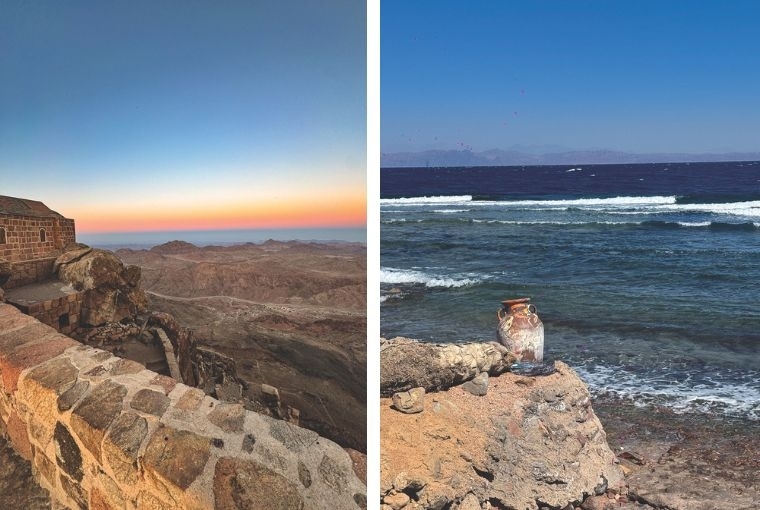
DAYS THAT DRIFT LIKE THE TIDE: NOTES FROM DAHAB
The vast desert of Sinai gradually softens into Dahab, a relaxed and soulful coastal town nestled between rugged mountains and the crystal-clear waters of the Red Sea. It’s easily one of Egypt’s best kept secrets. Once a Bedouin fishing village, it still holds onto its slow, unpolished charm. Dahab draws people who’ve paused something. Travellers, in between chapters, divers chasing silence below the surface, artists painting sunsets on scraps of driftwood. It’s a place where you come to slow down—and maybe stay longer than you planned.
I arrived here on a particularly windy afternoon and the sky above the lagoon danced with colourful kites. The winds that day made for an exciting Kitesurfing challenge. The waters are shallow and flat with protected Sandbars perfect for beginners and experienced riders. I met people who had been Kitesurfing here from all over the world. The community attracts seasoned riders, travelling instructors and passionate locals. It felt open and warm, full of stories, shared meals and wind-worn smiles.
I waited for the winds to soften before my first dive. At the Lighthouse eef, I met Tariq—my guide for the day. A local instructor and a skilled, calm, diver, he once lived in New York before choosing slowness over speed. I was led into the waters and slowly sank into the quiet hum of the sea. Below the surface, a whole new world unfolded. Sunlight filtered through like liquid gold, lighting up coral gardens that looked almost unreal in their colour and detail. Schools of electric-blue fish drifted past. Soft corals swayed gently with the current, their colours shifting with the light—pinks, purples and deep saffron. One coral looked like a giant cabbage, its florets blooming and closing in rhythm with the sea. Each part seemed to glow with a soft, rainbow-like aura. Now and then, a Lionfish floated by like a dancer in slow motion or a moray eel peeked out from the rocks, still and watchful. I was hooked—and found myself returning to dive again in the days that followed.
In places like the Blue Hole or The Canyon, the seascape becomes even more dramatic. Vertical drop-offs, underwater arches and narrow passageways remind you that you’re inside a living cathedral, carved by time and water.
Days unravel ceremoniously here. Mornings are high on adrenaline followed by relaxing sunset Yoga, sound baths and healing circles. I particularly remember a slow-cooked Tagine dinner at a cozy, family-run spot called Zanooba.
Time moves slowly in Dahab—but slips by fast.
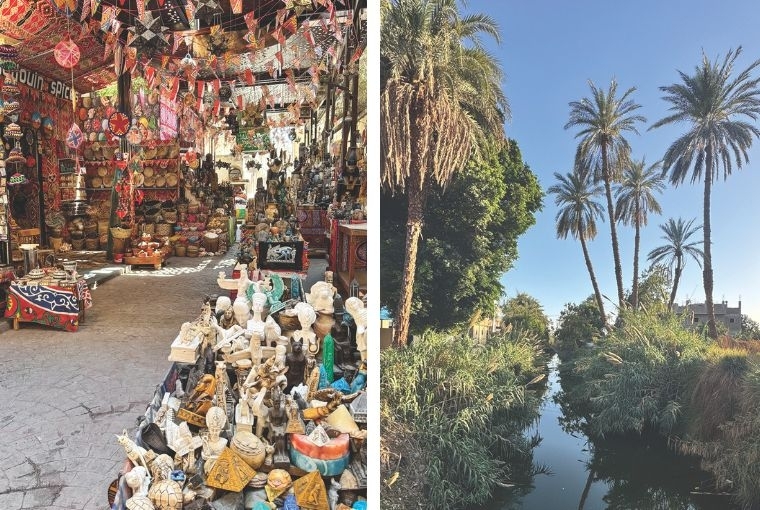
LUXOR: LIFE, AFTERLIFE AND THE NILE
Arriving into Luxor feels like being received by the Nile itself. It unfolds like a garden carved by the hands of the river. Fields of sugarcane, palm trees, banana groves and crops stretch along the riverbanks. Villages cluster close to the water and feluccas glide over the Nile. The streets are lined with fresh harvest of fruit and vegetables—all offerings from the river.
The agricultural calendar of ancient Egypt followed the sacred rhythm of the Nile’s annual flood—a cycle so steady, it became the backbone of their civilization. Each June, rains from Ethiopia caused the Nile to swell, gifting fertile silt to its banks. To the Egyptians, this was no accident—it was a gift from Hapi, the Nile god and a sign that Ma’at, the cosmic order, was in balance.
We arrived at the West Bank, welcomed by our friend and guide Constanza— Connie, as she prefers. Originally from Buenos Aires, she moved to Luxor five years ago. An Egyptologist by training, she now leads spiritual retreats for women. Her work weaves ancient wisdom with restorative work rooted in the sacred feminine. Having her as our guide felt serendipitous.
First look and Luxor appears like an open air museum without walls. Stepping into the temples of Luxor and Karnak feels like entering a space that exists outside of time. The air is still, warm and heavy with memory. Sandstone columns rise like ancient trees, their surfaces carved with stories—gods with falcon heads, lotus crowns and arms outstretched in eternal offering. Light filters through the high stone beams, casting long, golden shadows that move slowly with the sun.
At Karnak, the sheer scale is humbling. Rows of colossal columns in the Great Hypostyle Hall reach up to the sky, their tops still bearing traces of blue and red pigment. You walk among them slowly, instinctively quiet. This was once the most important religious complex in Egypt, dedicated to Amun-Ra, the sun god and the heart of the spiritual life of Thebes.
The temples were not just monuments—they were mirrors of the cosmos. It was believed that what was built in stone reflected what existed in the heavens. The alignment of the temples, the direction of their gates, even the placement of sacred lakes within the complex—all followed celestial patterns. Connie exclaimed, ‘These were spaces where 153 earth and sky could speak to each other’.
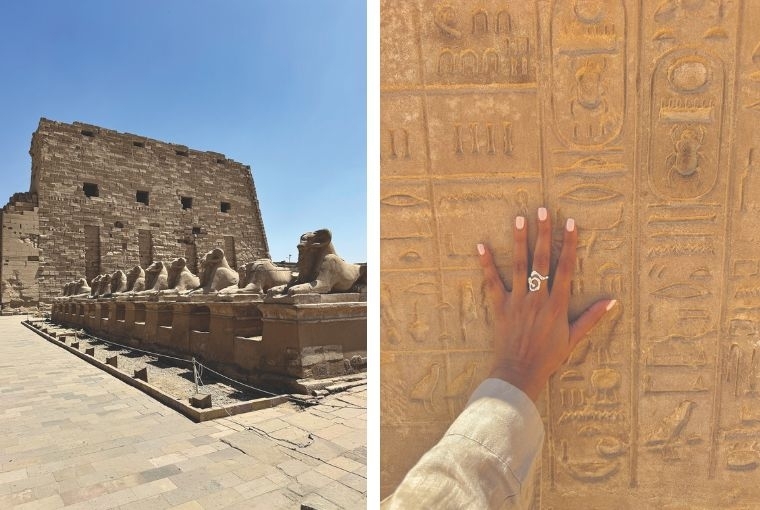
AT DENDERA, WHERE THE STARS REMEMBER
Connie had saved the best for last when she led us to Hathor’s temple. Before this exploration she made an offering to set our intentions over a ceremonial Blue Lotus tea. A flower, sacred to the Egyptians, known for opening with the sun and closing with the stars. In myth, it was a symbol of rebirth and inner vision, used in rites and healing. Found in carvings across Dendera, it connected us to Hathor’s temple not just through stone but through ritual.
This temple felt different from other sites in Egypt. It didn’t tower in dominance like Karnak or stretch into silence like the tombs. Instead, it draws you inward—into its chambers, its shadows and something softer, something sacred. The energy here is unmistakable. Feminine. Magnetic. Ancient, yet alive.
The walls of this temple were dense with carvings—goddesses, priestesses, musicians, stars and symbols so finely etched they can be read beneath fingertips. Dedicated to Hathor, goddess of music, joy, love and fertility, the temple has long been a sanctuary of beauty, healing, and celestial order.
The ceilings are perhaps the most breathtaking part. In the main hall, they’re painted in hues of blue with an Egyptian zodiac, a cosmic map that blends astronomy and mythology—Nut, the sky goddess, arching across the stars; Isis and Osiris guarding time. One of the most iconic carvings, the Dendera Zodiac, was once housed here before being taken to the Louvre. Still, what remains is enough to make you pause.
Unlike many temples shaped by conquest or hierarchy, Dendera whispers of something else: the creative force of the feminine, the cyclical nature of time, the healing power of beauty and balance. Hathor was not a warrior goddess—she was a mirror, a sanctuary, a joy-bringer. The temple reflects that. There’s music in the silence here. A deep exhale beneath the stone.
In Egypt, each moment felt quietly purposeful—whether under the vast desert sky, within temples echoing ancient mysteries, or beneath the tranquil surface of the sea. The land, its people and its timeless beauty became gentle reminders that travel isn’t merely movement outward; it’s a quiet return inward, a subtle rediscovery of our place among the vastness.
Words and Photography Barbie Verma
(Barbie curates experiences and conversations about Slow travel and living intentionally via Theory of Slow.)
This article is from our May 2025 Bookazine. Grab your copy here.